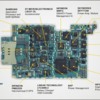I have had a half dozen butane irons. My Weller lasted longest and is still kicking.
I put it's value right up there with a cordless drill.
The two reasons for failure are usually; the heat deteriorated the screen than keeps the gas contains within the tips chamber. The usually still work, but without the red hot screen to ensure total ignition in at that point, flame can protude from the ports unexpectedly (small, hardly noticible by eye, but your piece or fingers may let you know  )
)
....the other reason is poor quality butane plugging the filter. A pita to try and find or replace. Letting them sit valve open for a long period of time (weeks months+) may let moisture in the filter evaporate and breath new life into one. Other contaminants can plug them forever. I bought food/medical grade butane when I could.
Look for packages with multiple tip sizes, micro torch tip, & adjustible heat.
When you light one, flame will be outside the tip. Let the screen get red hot, and the flame will begin to ignite before leaving the ports. Sometimes turning the gas down is necessary to have the flame "turtle" it's way into the tip.
I also prefer a handy Bic for lighting vs. the flint/igniter wheel on the iron's caps.
I kept one in my vehicles. You never know when you'll need flame or passive heat.








